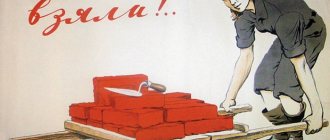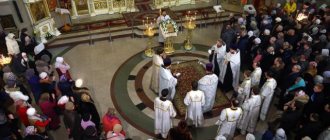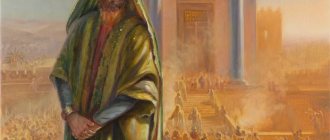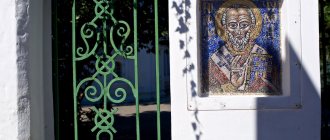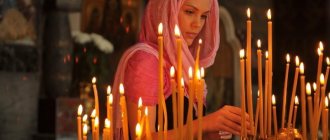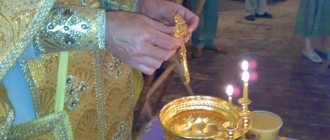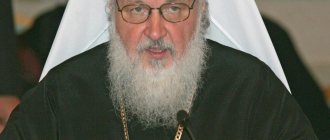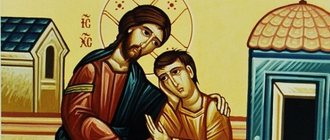When the baby Christ was born in Bethlehem, no one knew where it happened. King Herod, fearing that the born “king of the world” would remove him from the throne, sent the Magi to find him, who arrived in Judea to worship him.
The Magi found the Divine Child and brought him gifts of gold (as a symbol of royalty), incense - a symbol of divinity and holiness, as well as myrrh, symbolizing suffering and death. Despite the order of King Herod, having given honor to Christ, they did not return to the king and secretly left Judea, going to their own countries to tell about what they had seen.
Orthodox Christians do not celebrate Three Kings Day
Catholics celebrate the Adoration of the Magi on January 6, the day of the Epiphany. In some countries it is also called the Feast of the Three Kings. It is celebrated especially actively and magnificently in Spanish-speaking countries. To this day, a massive, magnificent procession is organized in honor of the holiday. It begins on January 5th and is called la festividad de los Reyes Magos or the cavalcade of the Magi Kings, during which the arrival of the three Magi in Jerusalem is dramatized.
Cavalcade of the Magi Kings, Bogota, Colombia. In many Catholic countries, in honor of the feast of the Three Kings, a festive procession is held, called the “Cavalcade of the Three Kings”
The Orthodox say that this event happened 12 days after the Nativity of Christ, while in Orthodoxy it is not customary to celebrate the day of the adoration of the Magi. The Orthodox version of this event is reflected in the ancient tradition of the Eastern Church. According to him, the worship of the Magi occurred after the Presentation. The Gospel of Pseudo-Matthew states that the wise men arrived in Jerusalem only two years after the birth of Jesus. Catholics celebrate their memory on July 23.
According to legend, the Magi were baptized by the Apostle Thomas and suffered martyrdom in eastern countries. According to legend, the relics of the Magi were found by Empress Helena and were first placed in Constantinople. In the 5th century, the relics of the Magi were transferred from there to Mediolan (Milan), and in 1164, at the request of Frederick Barbarossa, to Cologne, where they are kept in the Cologne Cathedral in a gilded triple shrine.
Shrine of the Three Magi behind the altar of Cologne Cathedral. The reliquary with the relics of the three wise men is kept in Cologne Cathedral
In addition to the three wise men, the Holy Scriptures also mention other wise men. This is how Balaam is known, who, instead of cursing Israel, was filled with the Spirit of God and blessed him (Num. 24). In addition, it tells about Simon the Magus, who turned to Christ and asked to become an apostle to receive the grace of healing, offering money for it (Acts 8:9-24).
Iconography
| Nativity of Christ with the Adoration of the Magi. Icon |
Images of the Magi, based on the Gospel narrative (Matt 2:1-12), as well as on apocryphal texts (Proto-Gospel of James, Gospel of Pseudo-Matthew), have been known since the 3rd century.
both in the painting of the catacombs and in the reliefs of sarcophagi. They are, as a rule, included in the compositions of the Christmas cycle and are not found as individual images. The most common stories with the Magi: the worship of the Virgin and Child, a journey to find a star, a conversation with Herod, a return to their countries. The Magi are depicted in short tunics, trousers and Phrygian caps, sometimes the clothes are ornamented, which emphasizes the Eastern origin of the Magi (for example, in the Church of the Assumption of the Virgin Mary in Daphne, c. 1100). In the scene of worship, the Magi with vessels in their hands are presented next to the Mother of God and Child sitting on the throne, either on one side (for example, the catacombs of Callistus, mid-3rd century, Lateran sarcophagus, c.), or on both sides (two wise men are depicted in the catacombs Peter and Marcellinus, late 3rd century; in the church of Santa Maria Maggiore in Rome, 432 - on the triumphal arch, next to the throne on which the Infant Christ sits, talking with Herod; the Magi in tight dresses embroidered with pearls and Phrygian caps ). In the church of Sant'Apollinare Nuovo (c.), the scene of the adoration of the Magi is on the north wall in front of a procession of martyrs approaching the Virgin. In the images of the Magi one can note new features characteristic of Byzantine iconography: if until now they were depicted as beardless, then here and in subsequent monuments Gaspar is presented as an old man with a gray beard, Balthasar as a medieval man, Melchior as a youth. The Church of Sant'Apollinare Nuovo illustrates the journey of the Magi on horseback and the Akathist. The veneration of the Magi in the Middle Ages was associated with the transfer of their relics from Milan to Cologne (1164). The lengthy tale of the “Three Holy Kings” by John of Hildesheim, along with the presentation of the legendary history of the Magi and the narration of the discovery and transfer of their relics, contains sublime praise for Cologne. The final 46th chapter, “On the glorification of the three holy kings, on how they should be praised,” testifies to the importance of their veneration for the Church. The peculiarities of the local Cologne celebration and Christmas mysteries influenced Russian iconography. Thus, on the Pskov icon “The Cathedral of Our Lady” (State Tretyakov Gallery, early century) the Magi are depicted presenting gifts (in their ordinary clothes) and singing the Christmas stichera (in deacon’s surplices).
The Bible says little about the Magi
It should be noted that the Bible tells little about the Magi. The Holy Scriptures do not say who the Magi were, where they came from, what they did or how they dressed. St. Matthew tells that the Magi lived somewhere in the east.
It is possible that this is Persia (in our time Iran), and the Magi are priests of the Iranian religion of Zoroastrianism. It, like Christianity, contains the idea of the coming of the Savior into the world. They saw a star in the sky and, like astronomers and astrologers, they realized that this was a sign.
Halley's Comet was used by Giotto as a model for the Star of Bethlehem in the Adoration of the Magi in the Scrovegni Chapel. Beginning of the 14th century. Scientists believe that the Star of Bethlehem, followed by the Magi, could be Halley's Comet
Following the Star of Bethlehem, the Magi crossed the territory of several states and arrived in Jerusalem. Here they turned to the ruler of Judea, King Herod, with a question. They wanted to see the newly born King of the Jews, whom they had come to worship. The Magi thought that this was his son or another relative.
Herod was afraid when he heard such news, since the new challenger could overthrow him. He politely escorted the Magi out. Before this, the king asked them, if they found the King of the Jews, to inform him about it. Herod supposedly wanted to go and worship him. The travelers left Jerusalem and followed the guiding star, which led them to Bethlehem. There they found Mary and the baby, bowed to him and brought gifts.
"Massacre of the Innocents", Matteo di Giovanni, 1488. Without waiting for the Magi to bring news of Christ, King Herod ordered the massacre of infants in Bethlehem in order to destroy a possible threat to his power.
The Bible says it this way:
“When they saw the star, they rejoiced with very great joy, and entering the house, they saw the Child with Mary His Mother, and, falling down, they worshiped Him; and having opened their treasures, they brought Him gifts: gold, frankincense and myrrh.”
Mf. 2:9-11
After this, the Magi had a Divine revelation in a dream that it was not worth informing King Herod about the success of their enterprise. That is why the Magi went home by a different route. Without waiting for their return, the angry Herod carried out the massacre of the infants in order to destroy the threat to his power.
Where did they live and what did they do?
Respect for witches in Russia was enormous - they could listen to their opinion more than the prince’s word. Despite such popular love and respect, Slavic sorcerers preferred to settle away from villages, in forests, near altars and temples. Some wise men lived in villages - then they chose their home on the outskirts.
With the advent of Christianity in Rus', they tried to denigrate the image of the Magi as being contrary to Orthodox teaching, so over time, the peasants began to fear the sorcerers, but respect for them did not disappear anywhere - for many years they came to the huts on the outskirts to get help, to be cured and to receive wise advice .
The range of responsibilities of the Slavic Magi in pre-Christian times was very extensive:
- caring for temples, maintaining idols and altars in order;
- naming newborns;
- participation in rituals at weddings, funerals, housewarmings;
- fortune telling and predictions;
- healing, compounding medicines;
- creating calendars;
- protection of settlements from evil spirits and negative influences from outside.
The Adoration of the Magi indicates the desire of the pagans to accept Jesus Christ as the King of Kings
The plot of the story that the three wise men came to worship the Divine Baby Jesus has a symbolic meaning. Moreover, this happened in fulfillment of many prophecies.
The adoration of the Magi to Christ speaks of the readiness of the pagans, together with the Jews, to recognize Jesus Christ as the King of kings. The acceptance of the gifts of the Magi symbolically indicates that God Himself wants to accept pagans and all people in general as participants in the New Testament.
Adoration of the Magi. Byzantine icon. The symbolic acceptance of the gifts of the Magi suggests that God is ready to accept all people into the Kingdom of Heaven, not just Jews
According to the tradition of the Roman Catholic Church, which calls the Magi kings, the names of the three Magi are Melchior, Caspar, Belshazzar. The story about them itself gained wide popularity thanks to the collection of the Italian Jacob of Voraginsky “The Golden Legend”, compiled around 1260. This explains its various inconsistencies.
So, for example, in early Christian literature the names of the Magi vary: for Origen they are Abimelech, Ohozat, Ficol; in the Syrian tradition these are Hormizd, Yazgerd, Peroz, etc. There are Greek versions of their names (Appellikon, Amerin and Damascon) and Hebrew (Magalat, Galgalat and Serakin).
From 3 to 12
the number of wise men varies
There are legends about a fourth magician, whose name is Artabanus (as the brother or descendant of the brother of the Persian king Darius I). In early manuscripts Balthasar is called Bethesarei.
The number of wise men also varies from 3 to 12. The generally accepted version stops at three wise men, who were representatives of three ages and three ancestors of post-Flood humanity.
The first of them, Melchior, is described as an old man, a descendant of Japheth, the second is the young man Caspar, a descendant of Ham, and the third is Belshazzar, a mature man, a descendant of Japheth. Thus, they symbolize all of humanity who came to worship the Savior and accept God’s will.
“Three Philosophers” - sages at the entrance to the grotto. Painting by Giorgione. The worship of the Magi exposes those of the Jews who did not come first to worship Christ
At the same time, the worship of the Magi exposes those of the Jews who should have recognized the Savior as one of the first, but did not do so. Thus, during the Old Testament, the Jewish people were entrusted with a special mission to be the custodians of faith in One God: they were “entrusted with the word of God” (Rom. 3:2).
The preaching of the Old Testament prophets contained indications of the time (Dan.9:24-27) and place (Matthew 5:2) of the birth of Christ, some of the circumstances of His ministry, His death and Resurrection (Hos.6:1-2). Thus, the Jews, and especially the scribes and priests among them, had to be the first to recognize the Messiah. They did not do this, but having told Herod where Christ should be born, they did not go and worship Him, just like Herod himself, who then sent executioners to Bethlehem to kill local babies (Matthew 2:16).
Literature
- Fortune telling books / Belova O. V., Turilov A. A. // Slavic antiquities: Ethnolinguistic dictionary: in 5 volumes / Under the general editorship. N. I. Tolstoy; Institute of Slavic Studies RAS. - M.: International Relations, 1995. - T. 1: A (August) - G (Goose). — P. 486–491. — ISBN 5-7133-0704-2.
- Sorcerer / E. E. Levkievskaya // Slavic antiquities: Ethnolinguistic dictionary: in 5 volumes / Under the general editorship. N. I. Tolstoy; Institute of Slavic Studies RAS. - M.: International Relations, 2004. - T. 3: K (Circle) - P (Quail). — pp. 528–534. — ISBN 5-7133-1207-0.
- Magi // Encyclopedic Dictionary of Brockhaus and Efron: in 86 volumes (82 volumes and 4 additional). - St. Petersburg, 1890-1907.
Spirits of the place Bannik • Bolotnik • Vodyanoy • Dvorovoy • Brownie • Goblin • Sea King • Ovinnik • Polevik • Mistress of the Copper Mountain • Shubin Mortgaged dead Vila • Drekavac • Kikimora • Mavka • Rusalka • Ghoul • Shulikuny Mythical creatures Alkonost • Asilki • Baba Marta • Baba Yaga • Babai • Bereginya • Bes • Blud • Buka • Witcher • Verlioka • Vechorka • Viy • Volkolak • Gamayun • Dabog • Dennitsa • Share • Zarya • Sinister • Zmey Gorynych • Ivan-da- Marya • Karakondzhul • Klobuk • Korgorushi • Cow Death • Koschey • Dashing • Fever • Frost • Week (Sunday) • Nochnitsa • Fiery Serpent • Midday • Friday • Rarog • Rozhanitsy • Sirin • Nightingale the Robber • Sudzhenitsy • Devil • Chugaister • Miracle -yudo • Shishiga • Yuda Ritual characters Bozhich • German • Dodola • Kolyada • Kostroma • Kostrubonka • Kupala • Madder • Maslenitsa • Yarila Mythical places Alatyr • Belovodye • Buyan • Iriy • Kalinov Bridge • Kitezh • Lukomorye • Bald Mountain • Currant River • Far Away Kingdom see also Slavic paganism • Pagan sanctuaries of the ancient Slavs • Literature on Slavic mythology Notes: 1 the historicity of the deity is controversial; 2 divine status is controversial.
The adoration of the Magi was witnessed by: Jesus himself, the Most Holy Theotokos, and also Joseph the Betrothed
The story of the worship of the Magi includes the Divine Child Jesus himself, the Virgin Mary, as well as Joseph the Betrothed. In Catholic countries, they are required to participate in Christmas performances (nativity scenes). In Orthodox countries, such performances have a different interpretation, and not all characters can be present in them.
Prophet Isaiah. Ugolino di Nerio, beginning. XIV century, London, National Gallery. The prophet predicted that the wise men would come on camels from the eastern countries and bring gifts to Christ
It is also worth mentioning the camels of the Magi, on which they arrived to Christ. The fact is that this was the prophecy of Isaiah about the visit of Jerusalem by the pagans. Here is his text:
“Many camels will cover you—dromedaries from Midian and Ephah; they will all come from Sheba, bring gold and incense and proclaim the glory of the Lord... And the sons of those who oppressed you will come to you in submission, and all who despised you will fall at your feet, and they will call you the city of the Lord, Zion of the Holy One of Israel.”
Is. 30:6-14
Thanks to this prophecy, the episode about the erroneous visit of the Magi to Jerusalem first became the basis for identifying the Magi with the kings.
The gifts of the Magi are now kept on Mount Athos
During his time, gifts were given to the infant Christ: gold, incense and myrrh. This is the fulfillment of another Old Testament prophecy. Here is his text:
“...the kings of Tarshish and the islands will bring him tribute; the kings of Arabia and Sheba will bring gifts; and all kings will worship him; all nations will serve him..."
Ps. 71:10-11
This phrase has a reference to the bringing of gifts to King Solomon of Israel by the Queen of Sheba as an event-prototype of the bringing of gifts to Christ.
Gifts of the Magi. In our time, the gifts of the Magi to Christ are kept in the monastery of St. Paul on Athos
The Magi started the tradition of giving gifts at Christmas. The Most Holy Theotokos kept the gifts and, before her Assumption, gave them to the Jerusalem Church. Here they remained until the year 400. After this, the gifts were transferred to the Church of Hagia Sophia in Constantinople by the Byzantine Emperor Arcadius. In our time, the golden casket with the gifts of the Magi is kept in the monastery of St. Paul on Athos.
By leaving a comment, you accept the user agreement
